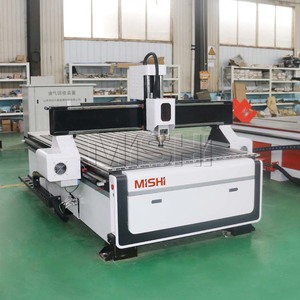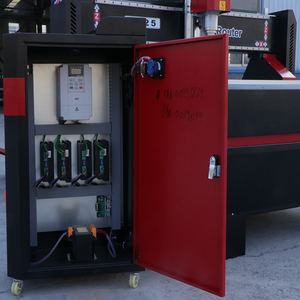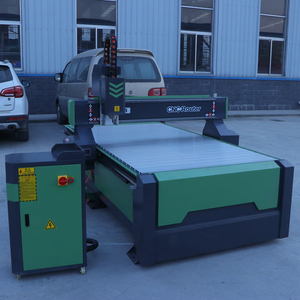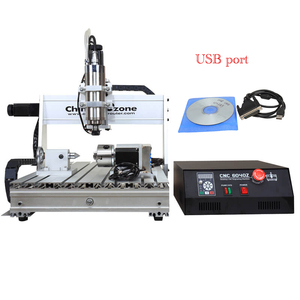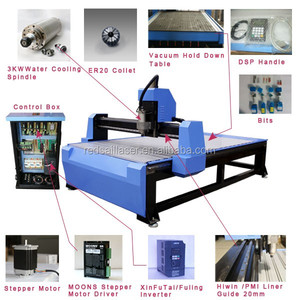Types of widely used CNC routers
A CNC (computer numerical control) router is a type of machinery that cuts various types of materials. It usually has a large cutting head and is controlled by a computer to cut any material in a shape or design that has been preprogrammed into the computer. A CNC wood router can be used for more than just wood carving, though that is the most common application of the device. Other materials a CNC router can cut through include glass, plastic, plywood, PVC, MDF, fiberboard, composite board, acrylic, aluminum, and rubber.
A CNC router machine may come with various types of spindles or cutters to make the design more customizable and the cutting more precise. The most common CNC router type is a desktop CNC wood router, usually suitable for small-scale and less-intensive projects. Other types of CNC routers, according to the shape and working area of the machine, include the following:
- CNC Wood Router: As the name suggests, a CNC wood router is explicitly designed to cut wood. This means that it is usually more affordable than other types of CNC machines. The device is primarily used in the carpentry industry for furniture making. However, it can also be used to make architectural models, sign-making, artistic engravings, and other related works. A wood CNC router machine often works well with softwood and hardwood materials, such as oak, pine, and MDF. It has an easy-to-use control system that allows for high-precision cuts and customized designs. Generally speaking, a CNC wood router machine will include laser and spindles that work best with light materials like wood, making it an ideal tool for carpentry work.
- Desktop CNC Router: A desktop CNC router is usually on the smaller side and, as a result, more convenient and easier to use than its larger counterparts. The machine can be placed on a standard work desk or table. Because of its smaller size, a desktop CNC wood router also comes at a more affordable price. Many small businesses and hobbyists prefer this kind of CNC cutting tool because it can be used to make jewelry, small gadgets, and other small-scale projects. A downside of the limited work area is that users of the desktop machine have to limit the material size they pick. However, a desktop machine is still well-equipped to work on common desktop materials like plastic, soft metals, rubber, foam, etc.
- ATC CNC Router: An ATC (automatic tool change) CNC router machine is usually equipped with a tool magazine that can hold multiple tools. This machine automatically changes the tool for the project, allowing for more efficient and continuous processing without manual intervention. The ATC router machines are also well-known for their high speed and accuracy and are often used in mass production.
- Plasma CNC Router: A plasma CNC cutting machine uses a high-temperature stream of plasma to cut various materials. Generally speaking, this machine is primarily used for cutting metals such as steel, aluminum, and titanium. A significant upside of the plasma CNC router is that it can make very precise and clean cuts, even in thicker metal sheets. It is also able to cut materials at a very high speed, making it an ideal tool for users who need heavy-duty support. Some common applications of the tool include metal fabrication, automotive industry, construction, and the production of custom parts.
Specification and maintenance of widely used CNC routers
Specifications
- Available sizes: The size of the widely used CNC router machine will determine what material it can cut and how big the project is. 4x4 routers are common for making smaller projects that use plywood or lumber. For bigger jobs that use larger sheets of material, a 4x8 CNC router is more standard.
- Control software: To operate a mostly used CNC router, there's a router software program that the machine is controlled by. It's usually CAD/CAM design software that allows a digital file with the object design to be created and sent to the router. The type of CAD/CAM design software is important because it affects what formats the files can be in and how easy it is for a person to learn and use the software to design things to cut with the router.
- Bit size: With a CNC wood router, the size of the bits, which are the little cutting tools, is very important. They are used for cutting different materials and making cuts of various depths. A wider (or larger) bit will be able to cut through thicker material and make wider gaps. Larger bits are great for doing rough cuts or getting the bulk of the material removed. More precise and smaller bits are better for fine details and precise cuts.
Maintenance
- Routine cleaning: Clean the widely used CNC woodworking router regularly after use to get rid of dust and chips. Ideally, users should use compressed air and a soft brush to wipe off the table, tracks, and other parts of the routing machine.
- Lubrication of moving parts: Regularly lubricate moving components, such as rails and gantry, by applying a small amount of high-quality lubricant/grease to ensure smooth operation and to minimize excess of dust accumulation.
- Inspect vacuum pumps: The CNC router widely used vacuum pump is responsible for holding workpieces on the table during the machining process and removing dust. Check the filter/cleaning system regularly to ensure the vacuum pump is functioning optimally.
- Managing tooling inventory: Widely used CNC routers employ different types of tools depending on the application. Some of these tools are single-use, while others are used multiple times. All tools should be properly maintained and managed as per their usability and condition.
- Paying attention to dust collection: Dust collection is critical to the functioning and longevity of a CNC router. Not only does it help to keep the work area clean, but effective dust extraction also prevents excess build-up of material on the router that can impair its performance and result in a reduced lifespan.
Uses of widely used CNC routers
The versatility of used CNC routers makes them suitable for use in multiple industries and applications. Here are some of the industries that widely use CNC routers and how these machines impact the sector:
- Signage industry: A used CNC router machine maker carves out custom designs for signage using different materials like metal, plastic, and wood. Also, used CNC router setups can etch letters and graphics onto signage for labeling purposes.
- Architectural industry: In the architectural industry, a used CNC router is ideal for creating architectural prototypes, making it easy to visualize the plan. As a durable material, architects commonly use plywood when making their prototypes. Once the design is finalized, adjustments can be made with ease using the CNC machine. In addition to this, a CNC router can be used for creating complicated architectural elements like moldings, trims, wooden panels, and decorative facets with precise size and detail.
- Furniture industry: Widely used CNC routers are popular tools in the furniture industry. They allow makers to create unique furniture with complex patterns. Furniture pieces made by a used CNC router include bookshelves, doors, window frames, chairs, tables, and cabinets.
- Musical instrument industry: The CNC used to create musical instruments such as guitars, violins, and pianos is efficient. An example is a guitar router kit, which includes a template to easily and precisely cut the body and neck of guitars. Using these outlines achieves a consistent and repeatable process, especially when making multiple instruments. Furthermore, the CNC machine offers artisans the ease to create an accurate and complex design.
- Advertising and marketing industry: CNC machines are used to design props, point-of-purchase displays, promotional fixtures, and trade show exhibits. A customized CNC router machine can build dramatic retail store displays.
How to choose widely used CNC routers
-
Business needs analysis:
First, it is crucial to evaluate the demands of the business. What is the sort of material the business generally works with? It may be wood, metal, acrylic, etc. Determine the size and thickness of the materials used to identify the necessary processing size and capacity. Consider the types of objects to be made, the desired precision and speed for achieving greater efficiency, and the budget restrictions to set reasonable goals and limitations for selecting a wide range of CNC routers.
-
CNC router types:
As mentioned before, widespread CNC routers have different kinds that meet different needs. A CNC wood router is the right machine for carpentry work like furniture making, sign-making, etc. A CNC metal router can deal with metal materials like aluminum, copper, etc. A plasma CNC router is suitable for tasks that involve using plasma cutting techniques on various types of metals. Consider the pros and cons of each to match the specific application.
-
Parts and features:
A CNC router machine is made up of various important parts. Consider the key components and features, including the spindle, control system, and software.
-
Supplier comparison:
When choosing a CNC router, it is imperative to research and compare different suppliers. Consider the reputation and customer feedback of the suppliers to get more details about the products and services they offer. Choose a supplier that offers extensive after-sales support, technical assistance, and the availability of spare parts.
Widely Used Cnc Router Q&A
Q1: What is the future of CNC routers?
A1: The future of CNC routers will likely be marked by automation and smart technology like machines that use AI technology for design analysis, automatic tool changes, adaptive machining, and remote monitoring and control.
Q2: What are the limitations of CNC routers?
A2: The common limitations of CNC routers include high initial investment and cost, requiring skilled operators for maintenance and repair, and software compatibility issues.
Q3: What is the difference between a CNC router and a CNC machine?
A3: A CNC router is a kind of CNC machine. Other types of CNC machines include CNC mills, lathes, plasma cutting machines, and wood cutting machines.
Q4: What are the advantages of a CNC router?
A4: The CNC router has a few benefits. It's a high-precision machine that makes the same cuts repeatedly without any variation, saving the operator a great deal of time. A CNC router also helps to reduce wastage and maximize material usage.
























































































































 Ready to Ship
Ready to Ship














